ACC511 Investment Analysis: Project Evaluation Task 2 - Report
VerifiedAdded on 2023/06/12
|8
|831
|432
Report
AI Summary
This report evaluates a project for RWE Enterprises, analyzing the cash flows, NPV, IRR, profitability index, and payback period. The analysis concludes that the project has a positive NPV and IRR exceeding the discount rate, making it financially viable. Additionally, the report compares two projects (A...
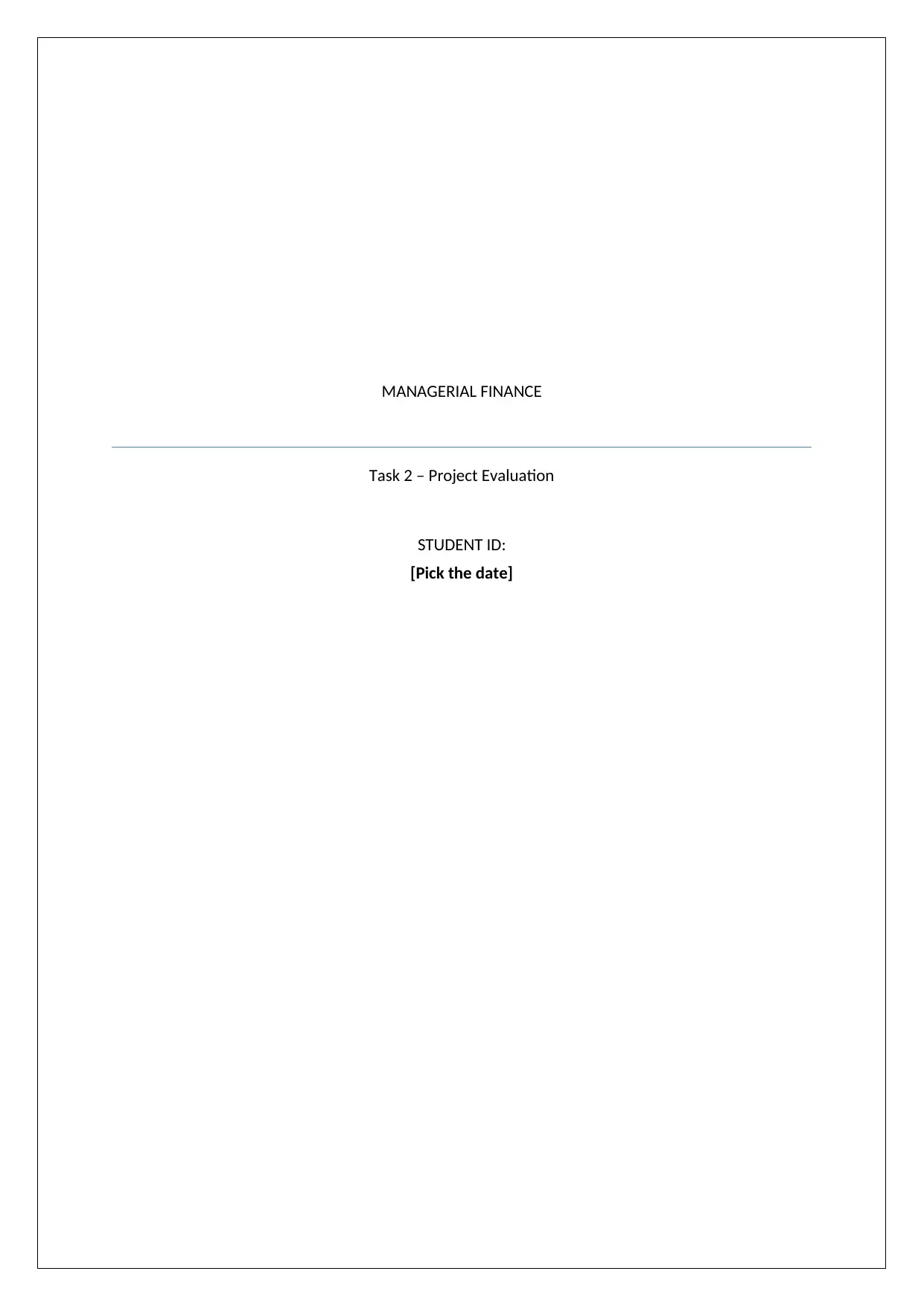
MANAGERIAL FINANCE
Task 2 – Project Evaluation
STUDENT ID:
[Pick the date]
Task 2 – Project Evaluation
STUDENT ID:
[Pick the date]
Paraphrase This Document
Need a fresh take? Get an instant paraphrase of this document with our AI Paraphraser
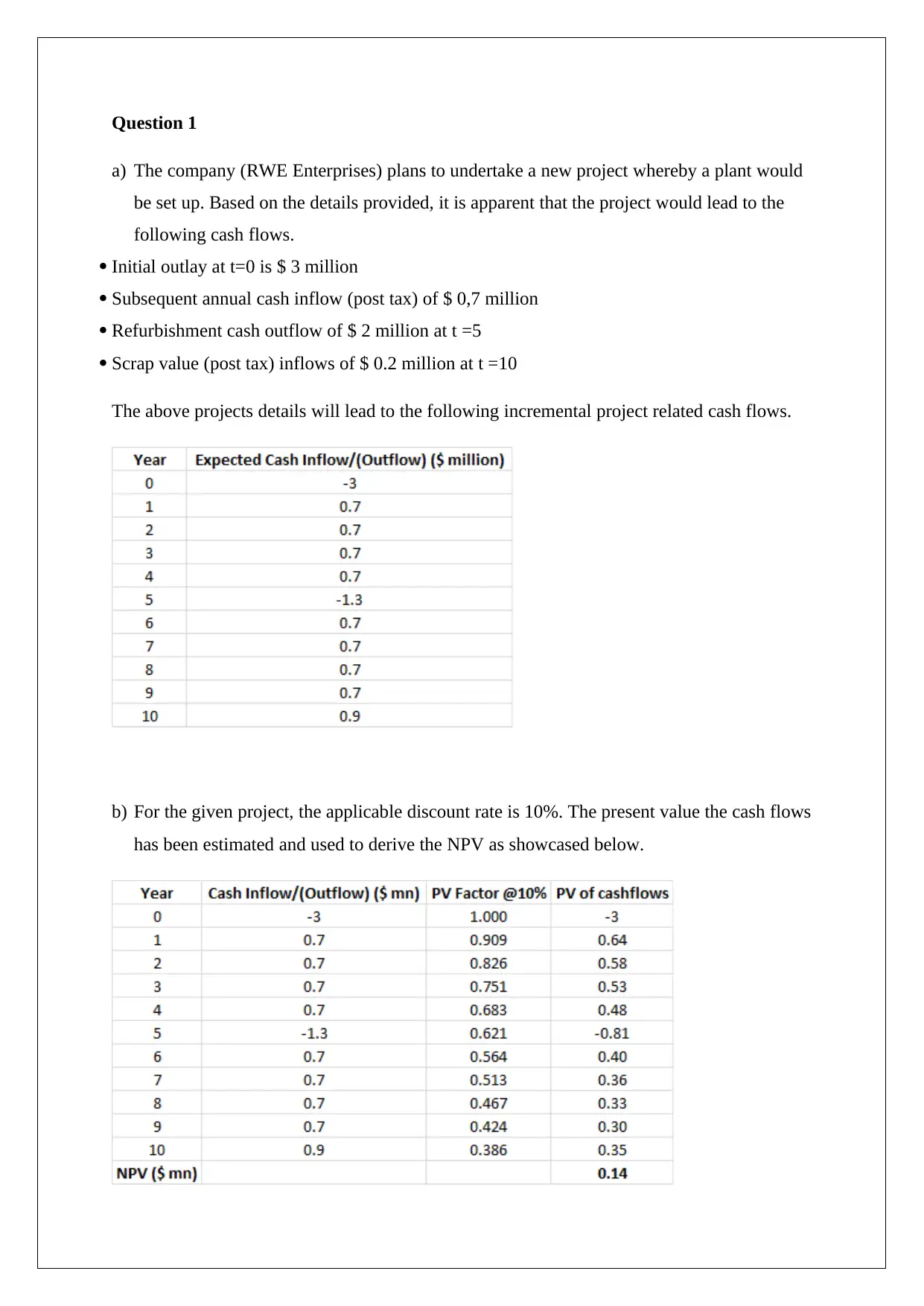
Question 1
a) The company (RWE Enterprises) plans to undertake a new project whereby a plant would
be set up. Based on the details provided, it is apparent that the project would lead to the
following cash flows.
Initial outlay at t=0 is $ 3 million
Subsequent annual cash inflow (post tax) of $ 0,7 million
Refurbishment cash outflow of $ 2 million at t =5
Scrap value (post tax) inflows of $ 0.2 million at t =10
The above projects details will lead to the following incremental project related cash flows.
b) For the given project, the applicable discount rate is 10%. The present value the cash flows
has been estimated and used to derive the NPV as showcased below.
a) The company (RWE Enterprises) plans to undertake a new project whereby a plant would
be set up. Based on the details provided, it is apparent that the project would lead to the
following cash flows.
Initial outlay at t=0 is $ 3 million
Subsequent annual cash inflow (post tax) of $ 0,7 million
Refurbishment cash outflow of $ 2 million at t =5
Scrap value (post tax) inflows of $ 0.2 million at t =10
The above projects details will lead to the following incremental project related cash flows.
b) For the given project, the applicable discount rate is 10%. The present value the cash flows
has been estimated and used to derive the NPV as showcased below.
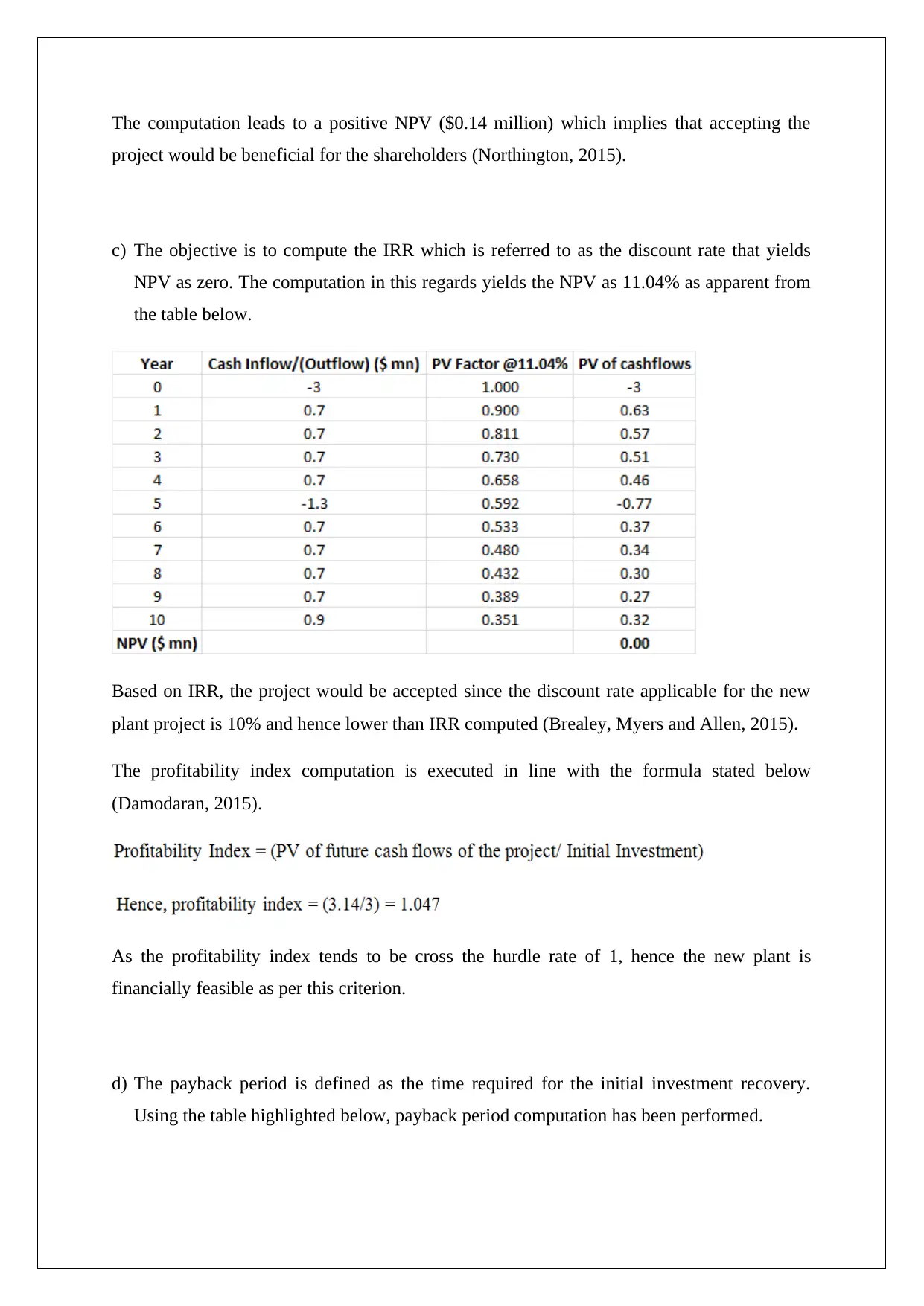
The computation leads to a positive NPV ($0.14 million) which implies that accepting the
project would be beneficial for the shareholders (Northington, 2015).
c) The objective is to compute the IRR which is referred to as the discount rate that yields
NPV as zero. The computation in this regards yields the NPV as 11.04% as apparent from
the table below.
Based on IRR, the project would be accepted since the discount rate applicable for the new
plant project is 10% and hence lower than IRR computed (Brealey, Myers and Allen, 2015).
The profitability index computation is executed in line with the formula stated below
(Damodaran, 2015).
As the profitability index tends to be cross the hurdle rate of 1, hence the new plant is
financially feasible as per this criterion.
d) The payback period is defined as the time required for the initial investment recovery.
Using the table highlighted below, payback period computation has been performed.
project would be beneficial for the shareholders (Northington, 2015).
c) The objective is to compute the IRR which is referred to as the discount rate that yields
NPV as zero. The computation in this regards yields the NPV as 11.04% as apparent from
the table below.
Based on IRR, the project would be accepted since the discount rate applicable for the new
plant project is 10% and hence lower than IRR computed (Brealey, Myers and Allen, 2015).
The profitability index computation is executed in line with the formula stated below
(Damodaran, 2015).
As the profitability index tends to be cross the hurdle rate of 1, hence the new plant is
financially feasible as per this criterion.
d) The payback period is defined as the time required for the initial investment recovery.
Using the table highlighted below, payback period computation has been performed.
⊘ This is a preview!⊘
Do you want full access?
Subscribe today to unlock all pages.

Trusted by 1+ million students worldwide
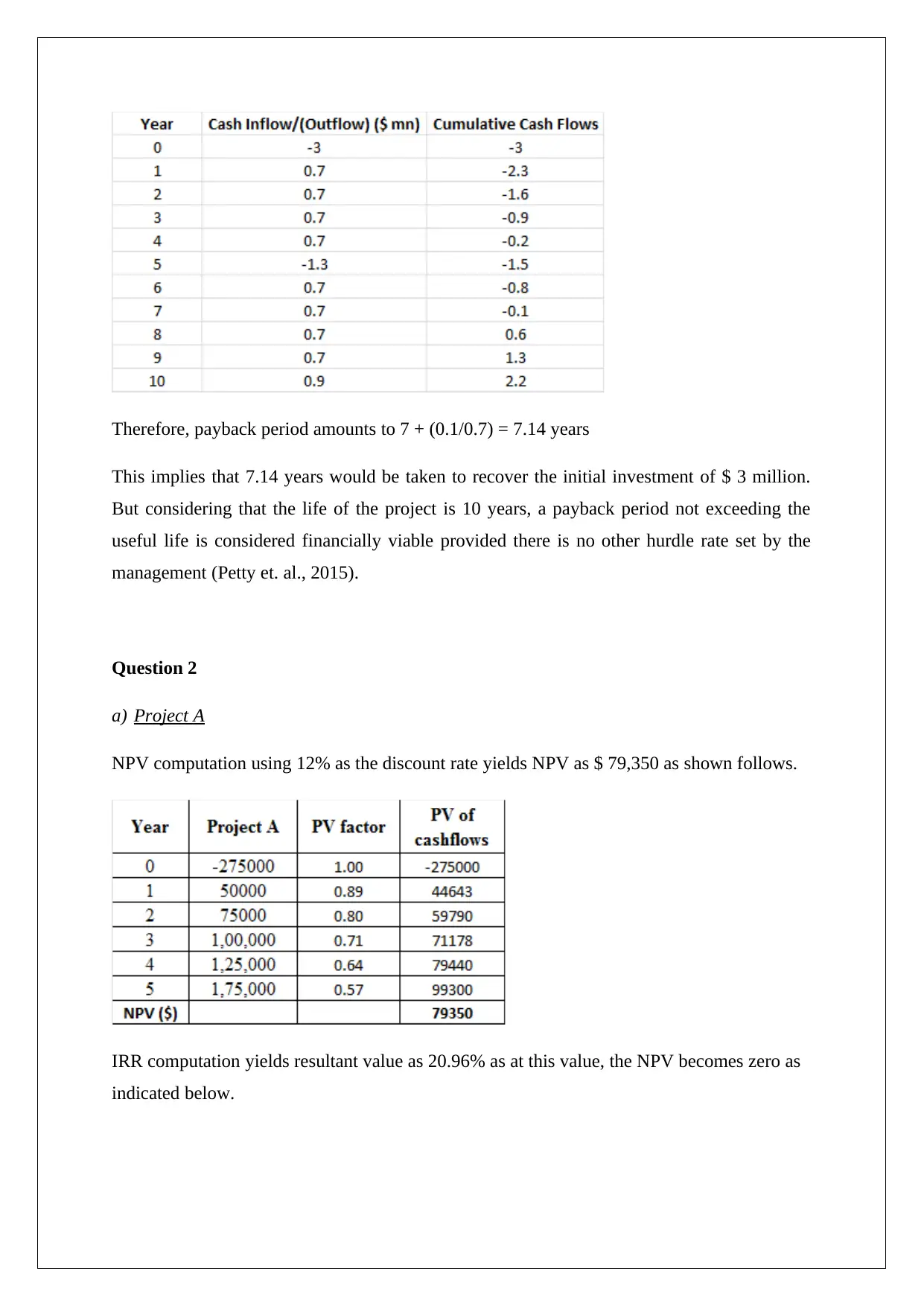
Therefore, payback period amounts to 7 + (0.1/0.7) = 7.14 years
This implies that 7.14 years would be taken to recover the initial investment of $ 3 million.
But considering that the life of the project is 10 years, a payback period not exceeding the
useful life is considered financially viable provided there is no other hurdle rate set by the
management (Petty et. al., 2015).
Question 2
a) Project A
NPV computation using 12% as the discount rate yields NPV as $ 79,350 as shown follows.
IRR computation yields resultant value as 20.96% as at this value, the NPV becomes zero as
indicated below.
This implies that 7.14 years would be taken to recover the initial investment of $ 3 million.
But considering that the life of the project is 10 years, a payback period not exceeding the
useful life is considered financially viable provided there is no other hurdle rate set by the
management (Petty et. al., 2015).
Question 2
a) Project A
NPV computation using 12% as the discount rate yields NPV as $ 79,350 as shown follows.
IRR computation yields resultant value as 20.96% as at this value, the NPV becomes zero as
indicated below.
Paraphrase This Document
Need a fresh take? Get an instant paraphrase of this document with our AI Paraphraser
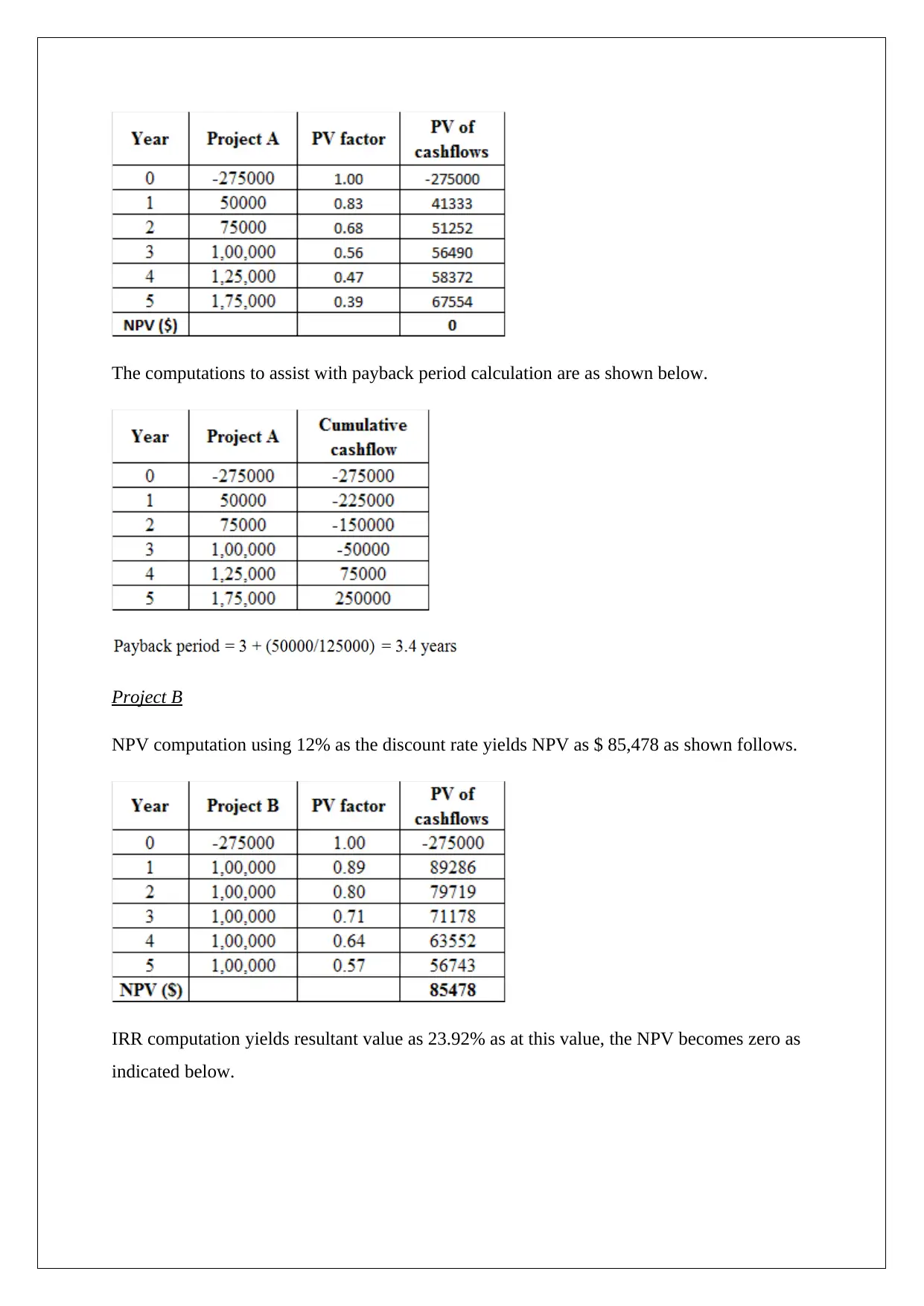
The computations to assist with payback period calculation are as shown below.
Project B
NPV computation using 12% as the discount rate yields NPV as $ 85,478 as shown follows.
IRR computation yields resultant value as 23.92% as at this value, the NPV becomes zero as
indicated below.
Project B
NPV computation using 12% as the discount rate yields NPV as $ 85,478 as shown follows.
IRR computation yields resultant value as 23.92% as at this value, the NPV becomes zero as
indicated below.
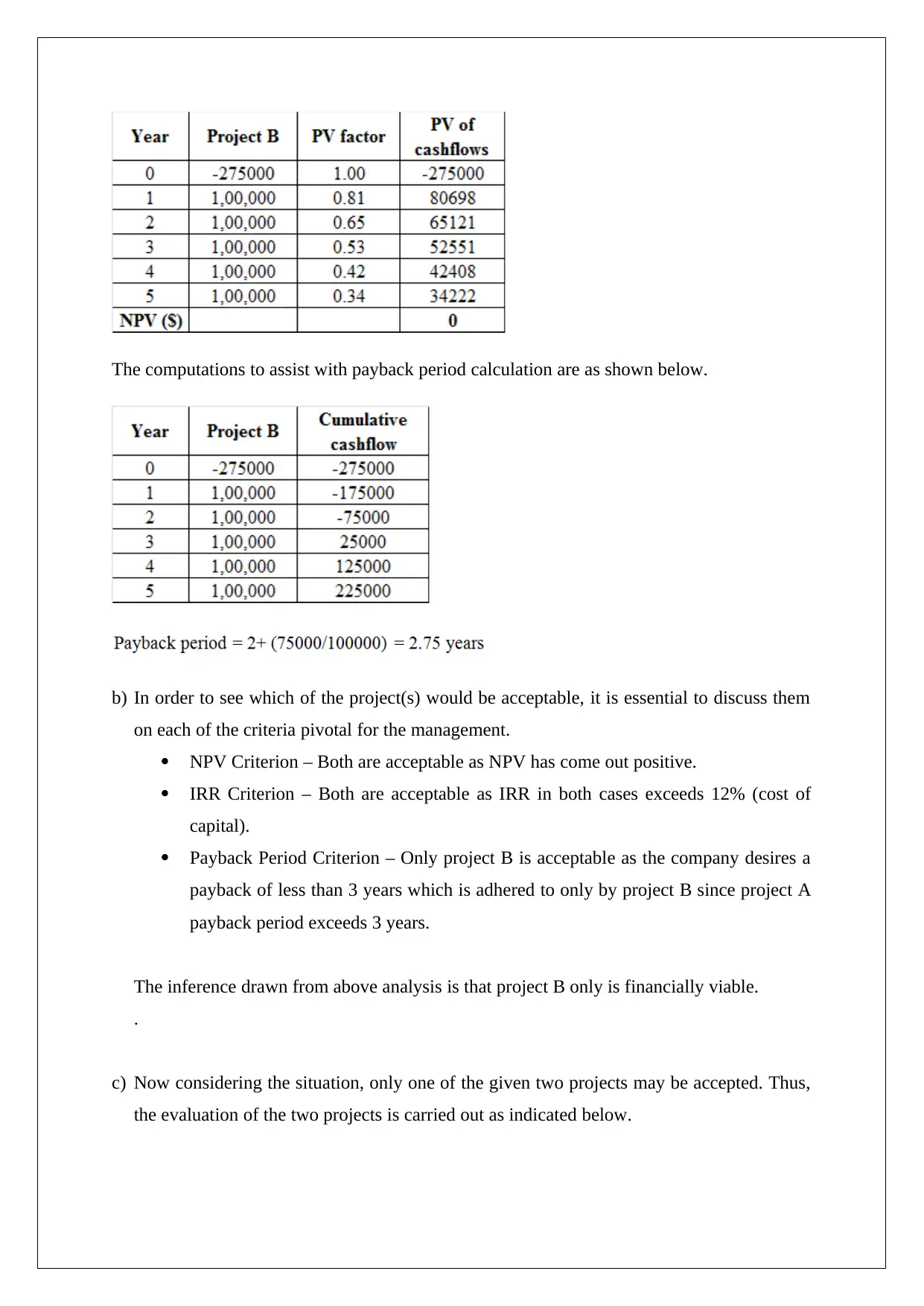
The computations to assist with payback period calculation are as shown below.
b) In order to see which of the project(s) would be acceptable, it is essential to discuss them
on each of the criteria pivotal for the management.
NPV Criterion – Both are acceptable as NPV has come out positive.
IRR Criterion – Both are acceptable as IRR in both cases exceeds 12% (cost of
capital).
Payback Period Criterion – Only project B is acceptable as the company desires a
payback of less than 3 years which is adhered to only by project B since project A
payback period exceeds 3 years.
The inference drawn from above analysis is that project B only is financially viable.
.
c) Now considering the situation, only one of the given two projects may be accepted. Thus,
the evaluation of the two projects is carried out as indicated below.
b) In order to see which of the project(s) would be acceptable, it is essential to discuss them
on each of the criteria pivotal for the management.
NPV Criterion – Both are acceptable as NPV has come out positive.
IRR Criterion – Both are acceptable as IRR in both cases exceeds 12% (cost of
capital).
Payback Period Criterion – Only project B is acceptable as the company desires a
payback of less than 3 years which is adhered to only by project B since project A
payback period exceeds 3 years.
The inference drawn from above analysis is that project B only is financially viable.
.
c) Now considering the situation, only one of the given two projects may be accepted. Thus,
the evaluation of the two projects is carried out as indicated below.
⊘ This is a preview!⊘
Do you want full access?
Subscribe today to unlock all pages.

Trusted by 1+ million students worldwide
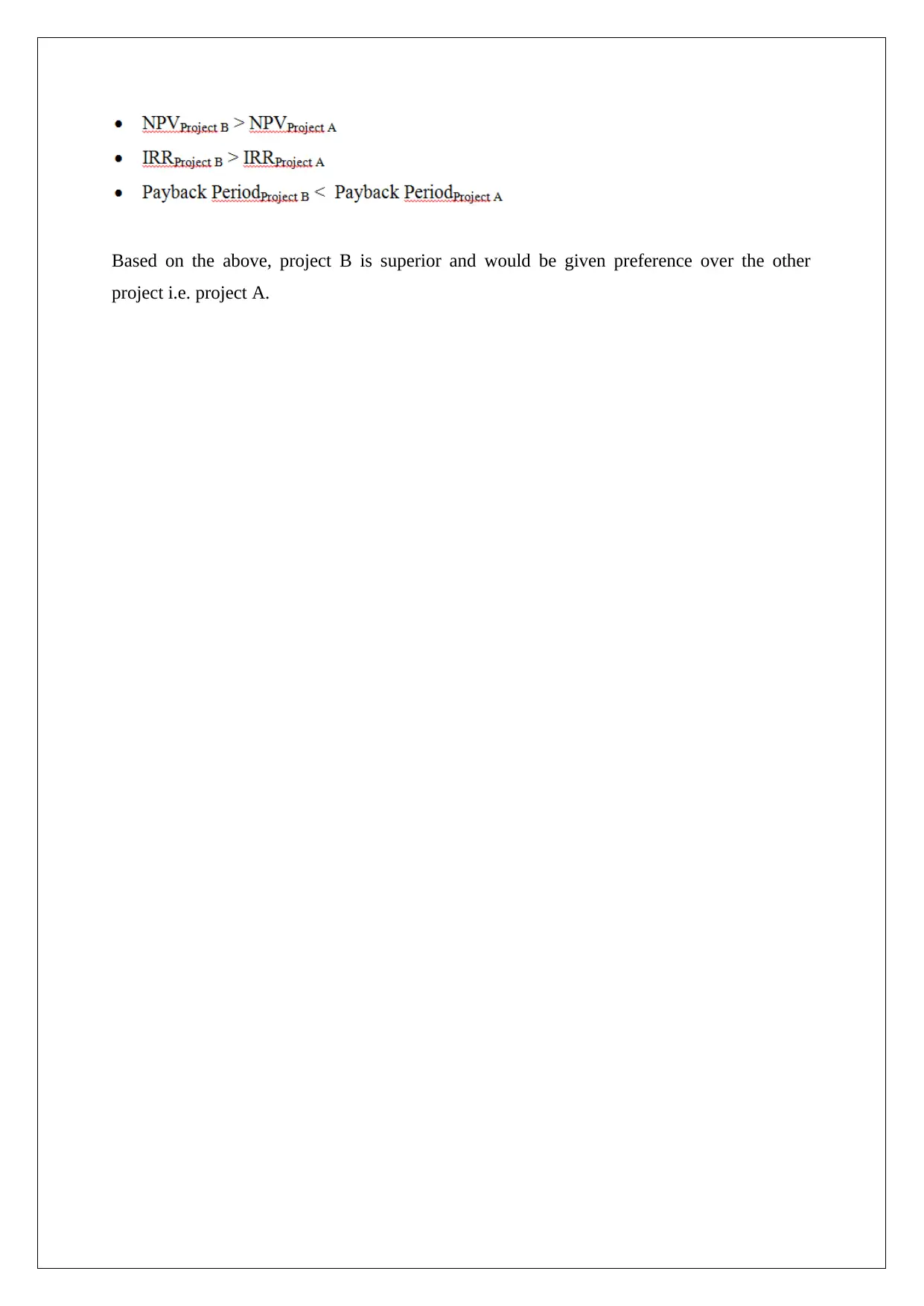
Based on the above, project B is superior and would be given preference over the other
project i.e. project A.
project i.e. project A.
Paraphrase This Document
Need a fresh take? Get an instant paraphrase of this document with our AI Paraphraser
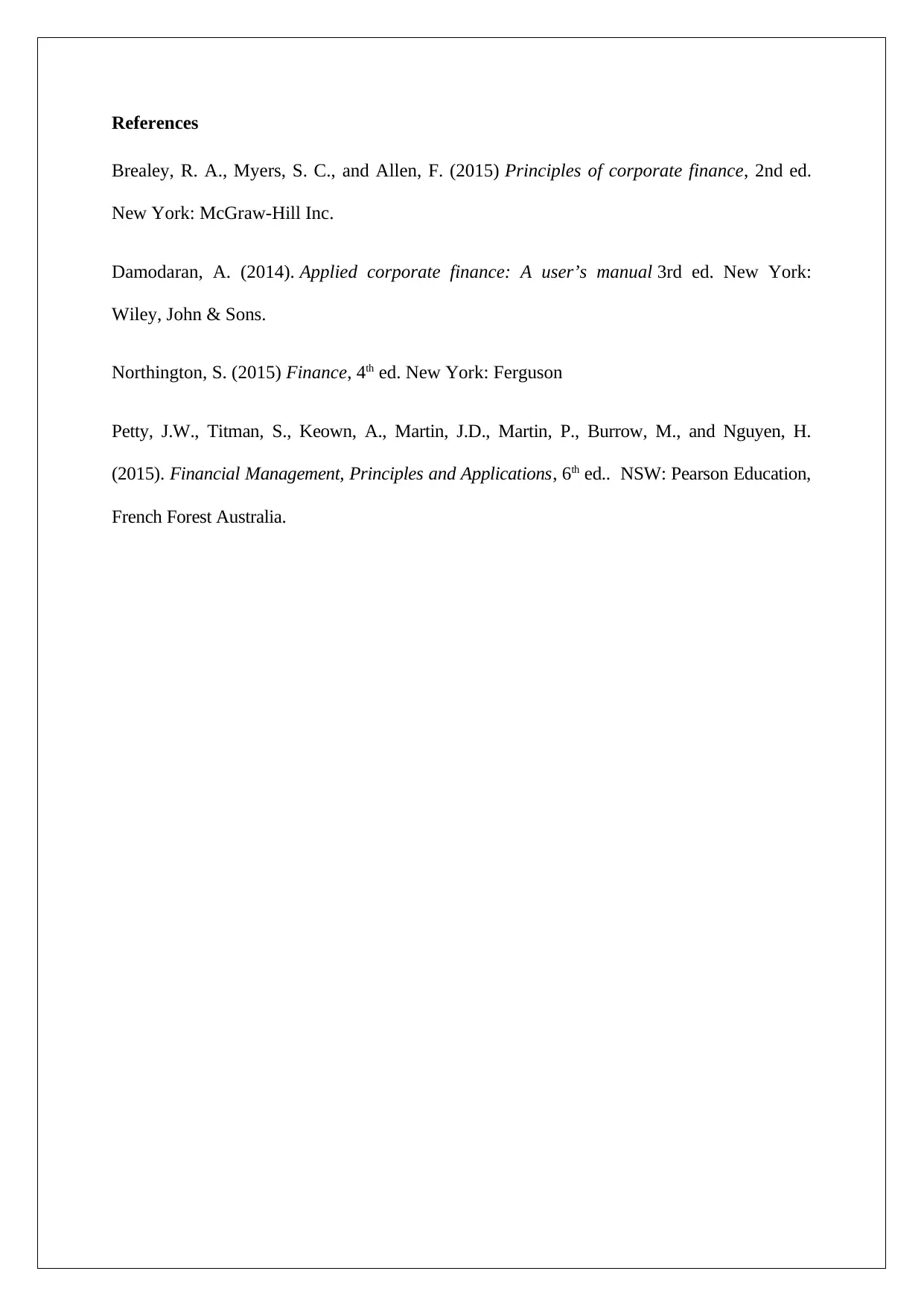
References
Brealey, R. A., Myers, S. C., and Allen, F. (2015) Principles of corporate finance, 2nd ed.
New York: McGraw-Hill Inc.
Damodaran, A. (2014). Applied corporate finance: A user’s manual 3rd ed. New York:
Wiley, John & Sons.
Northington, S. (2015) Finance, 4th ed. New York: Ferguson
Petty, J.W., Titman, S., Keown, A., Martin, J.D., Martin, P., Burrow, M., and Nguyen, H.
(2015). Financial Management, Principles and Applications, 6th ed.. NSW: Pearson Education,
French Forest Australia.
Brealey, R. A., Myers, S. C., and Allen, F. (2015) Principles of corporate finance, 2nd ed.
New York: McGraw-Hill Inc.
Damodaran, A. (2014). Applied corporate finance: A user’s manual 3rd ed. New York:
Wiley, John & Sons.
Northington, S. (2015) Finance, 4th ed. New York: Ferguson
Petty, J.W., Titman, S., Keown, A., Martin, J.D., Martin, P., Burrow, M., and Nguyen, H.
(2015). Financial Management, Principles and Applications, 6th ed.. NSW: Pearson Education,
French Forest Australia.
1 out of 8
Related Documents
Your All-in-One AI-Powered Toolkit for Academic Success.
+13062052269
info@desklib.com
Available 24*7 on WhatsApp / Email
![[object Object]](/_next/static/media/star-bottom.7253800d.svg)
Unlock your academic potential
© 2024 | Zucol Services PVT LTD | All rights reserved.




